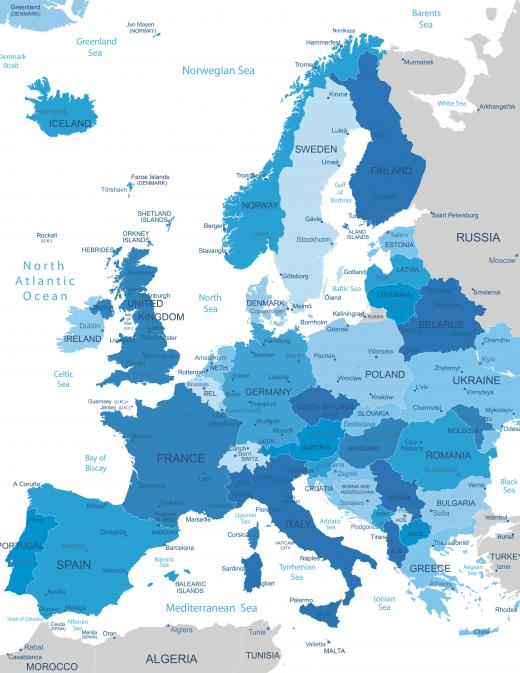What Is Doggerland?
 Michael Anissimov
Michael Anissimov
Doggerland is a "lost land" that existed in the present-day North Sea, between England, the Netherlands, and Denmark. Doggerland existed towards the end of the last Ice Age, about 11,000 years ago, when glacial ice in northern Europe had melted but sea levels were still low enough that the area was not flooded as it is today. Sea levels were about 120 m (394 ft) below current levels. Other areas around the world that were made dry by these sea levels include seas around Indonesia and the Bering Strait, which was crossed by hunter-gatherers into the Americas.
Doggerland was a rich habitat in its heydey, a paradise for humans and other animals. Being a low-lying area, it had abundant swampland and water for drinking, and was frequented by many animals. It formed a land bridge from mainland Europe to England and the rest of the United Kingdom. Southern Britannia was intermittently occupied by humans during the Mesolithic, but the most populated area appears to have been Doggerland. By mapping the geologic makeup of the floor of the North Sea, scientists have discovered submerged features such as hills, valleys, and riverbeds. The bed of the largest submerged largest river, similar in size to the present-day Rhine, has been named Shotton River after Birmingham geologist Richard Shotton.

The Doggerland region is considered crucial for understanding the Mesolithic (Middle Stone Age) period in northern Europe. The region is named after the Dogger Bank, a 20 m (65 ft) tall sand bank submerged in the North Sea, a moraine (accumulation of debris) created by glacial action. Scientists have studied Doggerland using AUVs (autonomous underwater vehicles) and divers, finding various tools including hand-axes, primitive boats, carved antlers, and human remains, including bones. These bones have been studied to analyze the diet of the humans that lived there.

Doggerland used to be occupied by mammoths, saber-toothed tigers, deer, and even lions. You can't really expect any domesticated animal in the list, since the circumstances won't really make that a possibility. Subfossilized bodies of these animals are sometimes uncovered by bottom-trawling fishing ships. It is thought that the area was relatively empty before 13,000 years ago, when a cold snap would have turned the area into frigid tundra, but after that, the climate began to warm up and the area got friendlier to life. About 10,000 years ago, the Ice Age finally ended, and the water levels began to rise. The rise would have been slow -- about one or two meters per century -- but by the time it was done, Doggerland was under water, and Britain became an island, which had occurred by about 8,000 years ago.
AS FEATURED ON:
AS FEATURED ON:













Discussion Comments
We just covered this in class. My Professor showed us an interactive map of this region from 9,500 BC to 8,000 BC and we could see Doggerland slowly flooding in it.
I've heard about the tsunami too, but based on this map, I think there was a general rise in ocean water across the globe. It was probably from melting glaciers. And I could also see many coastal regions in Europe, Mediterranean and Middle East being covered with the rising water.
@simrin-- Without human intervention, humanity probably will not set foot on Doggerland again. But the Brits could bring Doggerland up by throwing a lot of concrete and sand on it. Whether they would want to do that or not is a different question.
I find the history of Doggerland interesting too. I read an article on it recently in a magazine. The author of the article is doing some research on this subject and she said that even though Doggerland was slowly going under water over a long period of time, the final incident was actually a tsunami that caused the remaining parts to be flooded.
People might have still been living on this land when the tsunami took place. So it's not just about a lost land, but there is history of a pretty big and impactful disaster there too.
I'm curious as to what else scientists will discover about this. I would like to know more about who exactly lived on Doggerland and what happened to them after the tsunami.
This is so interesting. I've never heard of Doggerland before but the idea of Britain being connected to Europe is pretty cool. I think it must have been very exciting for people at the time to move into Doggerland since it was completely untouched and uninhabited.
The population of the world is rising and if the water levels decreased to the point where Doggerland emerged once more, I'm sure people would be more than happy to inhabit it once again.
I personally don't think that this will ever happen though because of global warming. I know that the glaciers are melting because of higher temperatures at the poles and sea water is rising for that reason. If anything, more and more land will become submerged in water. I don't think that humanity will have the chance to live on Doggerland again.
Post your comments